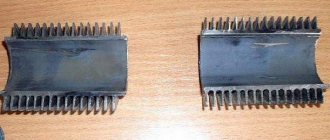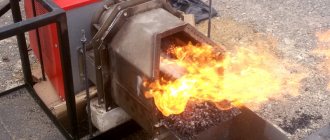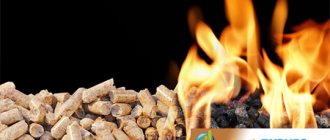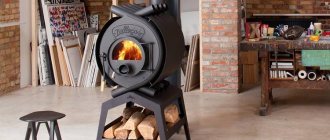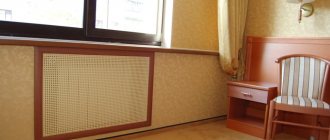Homeowners who heat their homes with solid fuel boilers and stoves know well how difficult and inconvenient it is to burn small fractions of coal, and even more so coal dust. Some of this fuel is poured into the ash compartment and ends up as waste, while the other blocks the air flow from the grate and therefore burns poorly.
The solution to the problem is to compress these small things into briquettes, which give good combustion and generate a lot of heat. Industrial coal briquetting has been used for a long time, but pressing technology can also be implemented at home. We study how to do this in this material.
Coal-wood briquettes: types of raw materials
The relatively low price, ease of manufacture, availability of purchase and efficiency of fuel briquettes have led to increasing popularity among consumers and their widespread distribution. Meanwhile, there are varieties of this type of fuel according to the raw materials used, as well as the shape of the final product.
Coal briquettes for heating are made from different types of coal, such as:
- brown (the most common and cheapest option);
- wood (more complex manufacturing technology, involving the use of additional equipment);
- anthracite (the most expensive, but also the most efficient raw material: the best heat transfer rates).
The production of briquetted fuel does not require high quality raw materials. Coal dust and fines are quite suitable for this purpose, as well as waste that does not sinter well, falls through the grate and is not suitable for direct use in furnaces or coke production.
Comparative characteristics of briquettes
| Type of fuel | Calorific value, MJ/kg |
| Anthracite | 26,8-31,4 |
| Brown coal | 10,5-15,7 |
| Coal | 20,9-30,1 |
| Gas | 27 |
| Peat (humidity 20%) | 15,1 |
| Diesel fuel | 42,7 |
| Wood (humidity 40%) | 6-11 |
| Briquettes (from sawdust) | 16-29,5 |
Each type of briquettes has its own characteristics and advantages. And although all of them are excellent for heating in domestic conditions, it is still worth familiarizing yourself with their characteristics in more detail in order to choose the best option.
Forms of fuel briquettes
Wood briquettes
This type of briquettes is obtained by pressing various wood waste - dead wood, sawdust, shavings, substandard wood. Before pressing, the waste is heated to a certain temperature, as a result of which an adhesive substance, lignin, is released from the cells. Thanks to lignin, briquettes acquire high strength and retain their shape during transportation and storage.
Wood briquettes
The advantages of briquettes over solid wood are obvious:
- the density of briquettes is constant and amounts to 1240 kg/m³, the density of wood depends on the species and ranges from 150-1280 kg/m³;
- maximum humidity of briquettes is 10%, wood – from 20 to 60%;
- when burning a briquette, the volume of ash is 1% of the total mass, wood - 5%;
- when burning, a briquette emits 4400 kcal/kg, wood - 2930 kcal/kg.
In addition, wood briquettes have other advantages:
- pressed wood does not spark when burning and emits very little smoke;
- a constant temperature is maintained in the boiler;
- briquette burning time 4 hours;
- the coals remaining after combustion are excellent for cooking over an open fire;
- the correct shape of the briquettes simplifies their transportation and storage.
Such fuel is sold not in cubic meters, like wood, but in kilograms, which is much more profitable.
Prices for Eurofirewood Briquettes
Eurofirewood Pini-kay
Coal briquettes
Coal briquettes
This type of briquettes is obtained from screening out coal. First, the screenings are crushed, mixed with a binder, and then compressed under high pressure.
The main properties of such fuel:
- coal briquettes do not smoke;
- do not emit carbon monoxide;
- burning time in conventional boilers is from 5 to 7 hours, with controlled air supply – 10 hours;
- suitable for use in domestic conditions;
- have a compact shape;
- when burning they release 5200k/cal and maintain a constant temperature;
- maximum ash volume – 28%;
- have a long shelf life.
Coal briquettes are the most optimal fuel in harsh winters, when pressure drops in domestic gas systems due to low temperatures. Briquettes burn at any temperature, the main thing is that there is a constant flow of air.
Prices for WEBER coal briquettes
WEBER coal briquettes
Peat briquettes
Peat briquettes
To make briquettes, peat is dried, heated and pressed under high pressure. The result is neat, light, dark-colored bricks. With an adjustable air supply, peat briquettes maintain the temperature for 10 hours, which is very convenient for heating the house at night.
Basic properties:
- suitable for all types of ovens;
- heat transfer is 5500-5700 kcal/kg;
- ash volume 1% of the total volume of the briquette;
- affordable price;
- minimum amount of impurities in the composition.
The ash that remains after fuel combustion can be used as an effective lime and phosphate fertilizer. For many owners of private households, this factor is decisive when choosing heating briquettes. Since peat is a flammable substance, it should be stored at a safe distance from open fire and heating devices. Even dust spilled from the packaging can ignite and cause a fire, so briquettes must be handled correctly.
Husk briquettes
Husk briquettes
Sunflower husks, buckwheat and rice husks, rye waste, oats and even straw are widely used to make fuel briquettes. The most common are briquettes made from sunflower husks, since the production of oil leaves a large percentage of waste. The maximum moisture content of husks for pressing is 8%, which increases heat transfer and reduces combustion time.
Sunflower briquettes
Specifications:
- briquette density is 1.2 t/m³;
- heat transfer – 5200 kcal/kg;
- ash volume from 2.7 to 4.5%.
Additional benefits:
- absence of harmful impurities;
- affordable price;
- long burning time;
- ease of storage and transportation.
Adhesives
Various components can be used as a binder, which affect the quality and characteristics of the final product. These are substances such as:
- coal tar;
- clay;
- soda;
- syrup;
- resin;
- dextrin;
- lime;
- protein and many others.
The choice of binding component directly depends on the type of main raw material and its quality. Also, depending on the use of a particular component, the technology for producing briquettes and its labor intensity will change.
Safety rules for coal preparation and briquetting
If you decide to use briquetted coal as fuel, you should approach its production with all responsibility. The components for the manufacture of solid fuel are selected depending on the place of its use. The composition of briquettes should not contain harmful components, so as not to be poisoned by the products of their combustion.
A low-quality product may have poor heat transfer and fail to cope with its direct responsibilities of heating the room. Poorly compressed briquettes will quickly turn into dust and go to waste.
What are they?
Coal briquette is a solid fuel product manufactured in the form of bars of various configurations and sizes, which are pressed under high pressure and temperature. Cementing components, which can be organic or inorganic, are used to hold together the particles of raw materials and strengthen the products.
The efficiency of this energy carrier lies in its heat transfer parameters and combustion duration, which are higher than those of conventional coal. The shape and density of the briquettes also play a role in efficiency because they allow the fuel to maintain an even, predictable burn and maintain a constant temperature throughout the combustion process. The waste remaining after attenuation in the form of ash is only 3%; for traditional coal this figure is 10 times higher, while the briquettes do not fall apart in the oven until they burn out completely.
Advantages and disadvantages of the product
Sellers of coal briquettes insist that the calorific value of their product is significantly higher than that of other types of fuel. This may be true, since the heat of combustion of 1 kg of anthracite is 8 kilowatts, and firewood and wood-based briquettes emit up to 5 kW/kg. The advantages of briquetted coal also include:
- enlargement of particles of the initial fraction;
- reducing the volume of harmful emissions into the atmosphere during combustion;
- high quality products with standard indicators;
- ease of storage and transportation;
- ease of spending control;
- combating spontaneous combustion of fine coal;
- environmental cleanliness and absence of harmful chemical additives;
- high heat transfer;
- ease of ignition and burning duration.
However, owners of solid fuel boilers cite a number of reasons for the low popularity of coal briquettes in comparison with their wood counterparts. The disadvantages include the following:
- the equipment is difficult to heat, and the fuel does not provide enough heat;
- when burning in the premises there are unpleasant odors;
- products crumble freely and become shapeless during transportation;
- A large amount of ash is formed.
Negative reviews are understandable if we remember that unscrupulous manufacturers, in order to obtain maximum profits, try to use charge, sludge and other coal products that are unsuitable for heating needs. Real anthracite briquettes with a rich black glossy color are difficult to find on sale. This leads to the logical conclusion that it is preferable to make coal briquettes yourself and purchase high-quality raw materials for this.
You should not waste effort and money on pressing low-calorie types of coal, although such briquettes, in proper combination with firewood, will significantly reduce overall costs during the heating season. Manufactured using a homemade method, they differ unfavorably from factory-made analogues: they produce little heat when burning, are fragile and are destroyed during transportation. But here it is possible to take care of the quality of the source material and adjust the content of additives. And the cost of homemade bricks, pillows and sausages turns out to be much more attractive than the prices of their factory-made counterparts.
Where to use and where not to use
It is mainly used for heating needs in everyday life, but recently it has become more often used in metallurgical and chemical plants, as well as power plants and boiler houses. In general, briquettes can be used in any enterprise or in a private home where equipment that runs on solid fuel is installed - coal, firewood, etc.
But you should know that under no circumstances should you use a charcoal briquette to start a fire in barbecues, grills and other ovens for cooking where there is direct contact of smoke with food. Such equipment is simply not designed for the temperature produced by this fuel, and it will fail, and the caustic and harmful substances contained in the coal released will make the food unfit for consumption.
Storage conditions for fuel briquettes
The clear shape and high density of the fuel blocks allows for a small storage area. On one cubic meter you can carefully stack up to two and a half tons of briquettes for the stove. In this case, the required level of environmental humidity should not exceed more than 80%.
It is not necessary to build a special room; compressed fuel can also be stored under a canopy. The main thing is that no moisture gets on it, and air circulates around it. Pressed husk fuel is considered to be the most vulnerable to moisture.
There are no harmful fumes coming from it. Not subject to spontaneous combustion. It practically does not absorb moisture from the air due to its high density. Therefore, performance properties are maintained for a long period of time.
Industrial production
Since the manufacturing technology differs somewhat depending on the type of binder, we can consider the production of coal briquettes based on the most commonly used component - coal tar (coal tar).
First, the raw materials are washed to remove impurities, and then crushed and dried to the required parameters. For this purpose, it is poured into the crusher through the receiving hopper, and then, through a screw, it enters the dryer. Dried coal fines are sorted into fractions: coals measuring from 0 to 6 cm go into the mixer, and larger ones go back into the crusher. After calibration, a binder is added to the mixer to the prepared base raw material.
When the necessary components are loaded, they are mixed into a homogeneous mass, which is distributed into the cells of the molds, where, through hot steam and high pressure, the resulting mixture is converted into a coal briquette. The resulting products are transferred to cooling bunkers for 8 hours. Screening out defective forms and subsequent packaging into 25 kg bags completes the production process.
About coal briquetting technology
One of the ways to burn coal fines is to light the boiler with wood, and then pour the dusty fraction of fuel on top of the burning logs. But this is too troublesome, since coal dust must be added in small portions, and therefore often.
If you load a large portion, then some of the fuel will definitely spill into the ash pan and go to waste, and the rest of the fuel will fill the cracks between the wood. Air will stop flowing into the combustion zone and, as a result, the firebox will begin to fade.
The best way is to use the pressing method to form briquettes from the fine fraction, which then burn very well, releasing a large amount of heat. Such a solution as coal briquetting was proposed at the beginning of the century before last in Russia by the inventor A.P. Veshnyakov is still successfully used both for industrial purposes and in everyday life. Its essence is that the compaction of fine coal using high pressure on special equipment makes it possible to obtain fuel whose calorific value is no less than that of high-quality coal.
Without going deeply into the intricacies of the technological process and the classification of different brands of fuel, we note that such briquettes are produced in two types:
- with binders for industrial purposes;
- without binders, intended for combustion in domestic boiler systems.
Note. Briquettes pressed with binders cannot be used in everyday life. When burned, these substances form harmful or toxic compounds, which are captured in industry in various ways. Previously, starches or molasses were also added to household fuel as binders, but this technology is outdated.
Since we are interested in the technology for producing coal briquettes without any additives for household purposes, it is worth considering this. So, the sequence of the process is as follows:
- first, the coal undergoes a grinding operation, with a maximum fraction size of 6 mm allowed;
- the next operation is drying in order to achieve an optimal humidity of 15%. For this purpose, special equipment is used for the production of coal briquettes - steam or gas dryers;
- After drying, the composition is cooled and supplied for pressing. The operation takes place at a pressure of 100-150 MPa in the so-called stamp press;
- final cooling and shipment to the warehouse.
Note. The traditional technological process is described here, but the requirements for the fraction size and moisture content of the raw materials may vary depending on the equipment used. For example, a modern mini-plant of the Russian company UNITEK requires particle sizes of up to 0.25 mm with a moisture content of 6 to 16%. That is, in this case, the coal briquetting technology should provide for better grinding, but the pressing pressure is applied much lower.
The output is a coal briquette, whose ash content does not exceed 15-20%, the maximum permissible mechanical load is 3 kg/cm2, and when dropped from a height of up to 2 m, the product loses no more than 15% of its mass as a result of impact. The heat of combustion depends on the grades of coal from which the briquette is pressed.
DIY coal briquettes
For these purposes, you can use a hand press or a homemade screw extruder. You can also, in the absence of equipment, do this manually. Unlike the factory manufacturing process, at home, instead of drying fine coal, it is mixed with water. No need to add binder. The main thing is to comply with two conditions:
- coal fraction - no more than 6 cm and the smaller the better;
- the resulting mass must be plastic and thick so that it can be sculpted by hand or briquetted in a mold using a hand press.
After the briquetting process, the products should be thoroughly dried. It should be noted that the coal briquette obtained by manual pressing is unsuitable for transportation, since it is more fragile than the factory one. Also, the manual method has very low productivity: it will take a lot of effort and time to prepare fuel for the whole season.
The use of an extruder speeds up the briquetting process, and the quality of the products is much higher than with the manual manufacturing method. Here you just need to pour raw materials into a bunker and get finished products of high quality that are suitable for transportation. However, the cost of the unit itself and its components (electric motor, gearbox, etc.) is high and not everyone can afford it.
Necessary equipment
As it becomes clear from the technology described above, to produce briquetted fuel you will need appropriate equipment, which is easy to make with your own hands. The main device is a press, which ensures the formation of a briquette from a crumbly raw material mass, characterized by a dense and uniform internal structure. A screw, lever or hydraulic mechanism can be used as a force body, with the help of which pressure will be applied to the raw materials used to produce fuel briquettes.
- drive mechanism, which, as mentioned above, can be screw, lever or hydraulic;
- a supporting frame on which all structural elements of the device are fixed;
- a matrix in the internal cavity of which a fuel briquette is formed from a loose raw material mass;
- a punch through which pressure is applied to the raw material mass;
- mixing drum (all components included in the raw material mass are mixed in it);
- trays designed for loading raw materials into the matrix and unloading finished products from its working chamber.
Scheme of a homemade impact machine with an electric drive
3D model of the shock-mechanical part of a press for the production of briquettes
To make briquettes from sawdust or any other suitable raw material, one press is not enough: this will also require auxiliary equipment:
- a crusher, with the help of which pre-cleaned raw materials will be crushed to fractions of the required size;
- mesh trays on which the finished briquettes will be dried;
- a ventilation unit necessary to remove the resulting dust from the raw material grinding zone.
Homemade biomass chopper based on an electric drill with a mixer attachment
You can produce Euro firewood yourself not only using screw, lever or hydraulic pressing equipment, but also using other types of technical devices. In particular, it is possible to use briquetting equipment of the impact-mechanical and extrusion type.
Like screw and lever type devices, briquetting equipment operating on the shock-mechanical principle belongs to the category of the least expensive in terms of self-production. When using such equipment, as when using screw and lever type devices, the produced fuel briquettes are not very dense, which makes them not very resistant to high humidity and significantly reduces their heat transfer level. In addition, such briquettes for heating, characterized by a rather loose internal structure, are unstable to mechanical damage, which eliminates the possibility of their transportation over significant distances.
Factory-made press VT60
The technology, which involves the use of extruder-type pressing equipment, is used primarily for the production of Euro-firewood in production conditions. A fuel briquette made using such equipment is characterized by a dense internal structure and, accordingly, high resistance to mechanical damage. When using extruder equipment, the pressure on the pressed raw material is exerted by a screw, which, rotating, moves the bulk mass to the holes of the matrix and pushes it through them. As a result, dense bars of cylindrical or hexagonal shape are formed.
Hydraulic press Green-440 for the production of briquettes RUF
To produce fuel briquettes using an extruder press, you do not need to add binders to the raw material. Such equipment, due to the peculiarities of its design, is capable of providing enormous pressure on the pressed raw materials, as a result of which the natural substance lignin is released from the latter, which acts as a binding component.
If you decide to make this type of pressing equipment with your own hands, keep in mind that this is a rather expensive undertaking, as it requires the use of expensive materials and special devices. That is why the option of independently manufacturing extruder-type pressing equipment is not often considered by home craftsmen.
How to get maximum benefit?
In order for fuel to retain its calorific value, it must be stored properly.
Although it is profitable to purchase coal in large quantities, you should not do this for several years in advance. The most unstable to storage is brown; it will last up to six months without loss of properties; anthracite has the longest shelf life, up to one and a half years. To store coal, choose a dark, well-ventilated place protected from moisture in a basement or shed. Fuel is placed in specially made wooden boxes or stored in bags.
Photo 4. Bag of coal. It is best to store coal fuel in such packaging.
Coal reserves are not afraid of precipitation, so they can be left in the yard. For such storage, choose a compacted area, pour coal on it, and compact it to reduce the air content, which promotes oxidation.
Industrial production
For the production of industrial briquettes, the following binders are used:
- oil bitumen mixture;
- cement;
- lignosulfonate additives;
- liquid glass;
- molasses.
To process small particles of coke and some other types of coal, cement and also liquid glass are often used. Such materials are used mainly in metallurgy, where the use of these substances is permitted.
Coal tar with petroleum bitumen is also used for the production of industrial coal briquettes. They cannot be used to heat residential buildings, as they release large amounts of benzopyrene and other toxic elements prohibited by the SES.
This article will help you make fuel briquettes yourself:
Varieties
Fuel briquettes differ in the material that is the main one in their production and the technology underlying their production.
The raw materials for fuel briquettes are:
- various wood of all species - shavings, sawdust, branches;
- dust and fine fraction of hard and brown coals;
- agro-industrial waste - straw, sunflower husks, buckwheat, rice;
- peat.
Let's consider the main technical characteristics of fuel briquettes made from various raw materials.
| View | Heat transfer, kW/kg | Humidity, % | Ash content, % | Approximate price for 1 ton, c.u. |
| Wood briquettes | 5,2-5,8 | up to 12 | 1 | 102 |
| Coal briquettes | 7,55 | 10-15 | 12 | 150 |
| Brown coal briquettes | up to 5 | 10-15 | up to 30 | 70 |
| Eurofirewood made from sunflower husks | 4,5-5 | 10 | 5 | 79 |
| Straw briquettes | 4,8-5,2 | 10 | 4 | 65 |
| Peat briquettes | up to 4.5 | before 18 | 20 | 90 |
Fuel briquettes should be stored in a well-ventilated area where there is no free access to moisture. In the summer, briquettes cannot be stored on the ground without being separated by a film from below from evaporation from the soil, since moisture condenses on the packs of briquettes at night. Therefore, on the bottom of the pallet under the packs it is necessary to arrange a hermetically sealed insulation from the ground, for example, you can use plastic film.
You can read about the features of fuel briquettes from manufacturers Ruf, Pini Kay, Nestro and Nilson here.
Simple cylindrical briquettes
This is the most common type of fuel briquettes, made in the form of cylinders. Sawdust and small wood waste are used as manufacturing materials. All this is pressed under low pressure using a non-toxic adhesive base. After this process is completed, the finished briquettes are put up for sale. Such fuel is inexpensive, but cannot boast of high strength. They tolerate moisture very poorly, crumble and fall apart.
Sunflower fuel briquettes
Fuel briquettes from coal and peat
Based on the name, it becomes obvious that coal and peat are used to create such fuel briquettes. Coal and peat briquettes are used for lighting stoves and solid fuel boilers. Fuel made from coal has a high combustion temperature, but it also produces a large amount of ash.
Fuel briquettes from coal
Scope of application
Sawdust briquettes have a fairly wide functionality. This fuel can be used:
- for heating a residential building. Due to their compactness, briquettes made from wood raw materials are suitable for fireplaces, stoves, and solid fuel boilers;
- when heating baths and saunas, if your main house is heated in some other way. Briquettes ideally suit all environmental conditions;
- on picnics. They are an excellent alternative to coal and firewood. Moreover, they can boast of a remarkable property: when fat gets on a hot briquette, the latter does not ignite and does not smoke.
By the way, sawdust briquettes should probably be recommended for cooking in closed spaces: there is no burning smell, and the dish is fried extremely evenly.
Manufacturing technology and scope
After processing natural raw materials, a large amount of waste remains. For example, in the woodworking industry these are shavings, sawdust, and wood chips. Each production strives for a waste-free operation scheme, so they have long learned to use even leftover raw materials to make the necessary products, for example, chipboard. With the rise in price of solid fuels, waste began to be pressed into briquettes that were convenient for use and transportation - and they immediately became in demand.
The technology for making wood briquettes for heating is simple: the waste is crushed, pressed, and simultaneously subjected to heat treatment. To bind particles together, the natural component lignin or synthetic solutions are used. Lightly melt the surface to maintain its shape.
To increase combustion efficiency, some types have through holes. Then small-sized products are packaged in film or paper bags; more protected briquettes are left unpacked. In this form, the products are sold for private and industrial needs.
When purchasing briquettes at retail or, which is much more profitable, wholesale, pay attention to the shape and size - they must match your boiler, stove or barbecue
The heat transfer of the fuel is sufficient for it to be successfully used for heating completely different rooms, such as:
- production workshops, warehouses with an area of up to 200 m²;
- utility rooms, boiler rooms;
- private properties: cottages, country houses, dachas;
- Russian baths, saunas.
Small-sized briquettes and granules can easily be placed in stoves of any size; for volumetric solid fuel boilers, “eurowood” of increased length or diameter is provided. One example: 30-35 kg of sawdust fuel is needed per day to heat a large warehouse hangar with an area of 180-200 m², that is, 3-3.5 standard ten-kilogram packages will be needed.
Light and compact briquettes are convenient for transportation in the trunk of a car, they burn well in the open air, so lovers of outdoor recreation prefer to take them with them for making fires, barbecuing or cooking on the grill. For summer residents, briquetted products are a universal means - they are successfully used both for heating houses and for starting a fire on the site.
Laying and pressing the resulting mass
Using a small bucket, the resulting mass is placed in all 4 compartments of the press, the jack with platforms is lowered down. It is necessary to understand that the compartments must be filled to capacity. After the press has completed its task, the briquettes will be only about 5 cm high.
The press compartments are filled with the finished mass of cardboard and coal dust
By rotating the jack handle, the operator lowers the platforms all the way down. All squeezed water is drained through a gutter into a bucket - it will later be used again.
The jack is designed in such a way as to neutralize human efforts. However, there comes a time when even he is not able to push the platforms any further. Then you need to wait a couple of minutes until the remaining liquid drains, and you can take out the almost finished briquettes. Why "almost"? Yes, they just need to dry thoroughly. While they are raw, they can be broken by dropping them from a height. But when the briquettes dry out, it becomes difficult to break them even with a hammer.
Using a jack, the mass is pressed into briquettes
What stoves can be heated with briquettes?
Briquettes are distinguished by their versatility. They can be used in any type of stoves, including brick ones. They emit about four and a half kcal per kg, which is quite acceptable for a heating device made from refractory bricks. The main advantage of briquettes compared to regular logs is that they burn out several times slower.
This fuel is economical and cheap. Regular logs need to be sawed, chopped, flattened and dried. And Euro firewood does not require lengthy preparation: it is enough to purchase it and store it in a dry room in film or original packaging.
The fact that the fuel burns slowly is a disadvantage for some premises. It will take several hours to warm up the house in winter. The heat from such fuel is much less. And after the combustion of briquettes, the ash has a characteristic pungent odor.
Material selection
Thermal conductivity
The determining factor in the quality of European firewood is the raw materials for production. Most briquettes for heating with your own hands are characterized by low heat transfer precisely because of incorrectly selected and prepared manufacturing materials.
The most popular waste products currently used are wood processing industry waste – sawdust, shavings, etc.
Wooden briquettes for heating
Sawdust briquettes
In reviews of briquettes for heating, the most controversial opinions are expressed about wood models. This can be explained by the characteristics of the original manufacturing material. Unlike coal briquettes for heating, European firewood made from wood waste has one significant drawback - moisture absorption.
This can lead to artificial weight gain due to increased water content. Alas, there are no regulatory documents for the production of Euro-firewood. Therefore, manufacturers most often introduce internal standards, which may not always meet customer expectations. If the technology was followed during the production of wood briquettes for heating, then the product must meet the requirements from the table.
| Characteristic | Meaning |
| Bulk mass, kg/m³ | 125 |
| Briquette density, kg/m³ | 1150 |
| Humidity, % | 6-10 |
| Calorific value, MJ/kg | 25 |
| Ash content, % | 0,5-1,3 |
How to distinguish a quality product from a dubious one? The first one must have a number of qualities:
- Uniform surface firing or correct shape of RUF cubes;
- No condensation on the surface or water stains;
- All briquettes from the same batch have the same shape and size.
But besides this, you need to ensure the correct storage location. To do this, it is recommended to use a separate room with normal ventilation and room temperature. When organizing heating with sawdust briquettes, the fuel is most often stored in an adjacent room.
Other methods and recipes for making long-burning briquettes
In fact, anything that burns can serve as raw material for such fuel. But soaked cardboard will always be used as a basis. In any case, it is also soaked and crushed in a washing machine (you can use a drill with a mixer attachment, but this will take too much time). The difference will lie in the second component. Instead of coal, you can add a couple of buckets of chopped leaves. You shouldn’t fill the leaves whole - they won’t be saturated with the paper pulp, which means the briquette will flake and burn very quickly (and smokily).
PHOTO: youtube.comA cardboard briquette with leaves is quite good fuel for a stove
Another option is mixing shredded cardboard with sawdust. Many claim that this “recipe” is even better than using coal dust. This is quite possible, because the composition will contain almost 4 times more sawdust than coal. Otherwise, everything is done identical to the first option.
ADVANTAGES OF BRIQUETTED COAL
Technical solution:
- Receiving a product of the same size, volume, shape and weight.
- Elimination of the problem of dust formation and defects during transportation.
- Specified hardness and strength of the briquette.
- Recycling waste into commercial products
Consumer and marketing benefits:
- Higher energy value
- Longer burning
- Ash in powder form
- Less CO2 and sulfur emissions
- Easier packaging, transportation, storage
- Ready for automatic feeding into the firebox
- Possibility of packaging for the consumer market
- Export supplies
